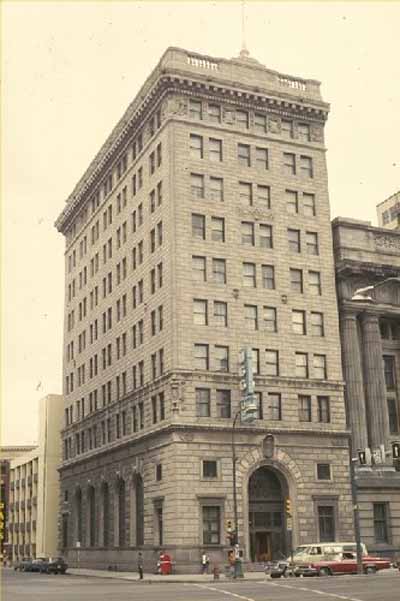Early Skyscrapers in Winnipeg National Historic Site of Canada
Winnipeg, Manitoba

Front elevation
© Agence Parks Canada / Parks Canada Agency.
Address :
Main Street and McDermot Avenue, Winnipeg, Manitoba
Recognition Statute:
Historic Sites and Monuments Act (R.S.C., 1985, c. H-4)
Designation Date:
1981-01-15
Dates:
-
1912 to 1918
(Construction)
Event, Person, Organization:
-
J. Wilson Grey - Confederation Building
(Architect)
-
John D. Atchinson - Union Trust Building, Bank of Hamilton
(Architect)
Other Name(s):
-
Early Skyscrapers in Winnipeg
(Designation Name)
Research Report Number:
1980-25, 2005-SDC/CED-001
Plaque(s)
Existing plaque: Main Street and McDermot Avenue, Winnipeg, Manitoba
The skyscraper was a by-product of technological advances and increased urbanization of the late 19th century. Steel-frame construction, the elevator and rising land values made multi-storeyed buildings structurally and economically feasible. Between 1900 and 1916 twelve skyscrapers were built in Winnipeg, imposing on the city the verticality and high density of a modern urban core. All were monolithic structures decorated in a variety of styles. The classicized Bank of Hamilton (1916) and the Italianate style of the Union Trust (1912), located directly across the street, typify Winnipeg's early skyscrapers.
Description of Historic Place
The Early Skyscrapers in Winnipeg National Historic Site of Canada is a grouping of three tall commercial buildings within Winnipeg’s Exchange District National Historic Site of Canada, the historic business core of the city. They exhibit a variety of stylistic details but generally conform to the then-prevalent Chicago style for the incipient skyscrapers appearing in increasingly densely built city centres. The designation refers to the Union Trust Tower, the Confederation Building, and the Bank of Hamilton building on their footprints.
Heritage Value
The Early Skyscrapers in Winnipeg were designated a national historic site of Canada in 1980 because: decorated in a variety of styles, these buildings typify, as a group, Winnipeg’s early skyscrapers, which imposed on the city the verticality and high density of a modern urban core.
Their heritage value resides in their impact as a grouping of relatively tall, monolithic structures whose articulation derives from the new technological and aesthetic trends emanating from the booming metropolis of Chicago, Illinois. In the early twentieth century, when these ten-to-thirteen-storey buildings appeared, they set a new standard for increasingly dense urban construction.
Source: Historic Sites and Monuments Board of Canada, Minutes, June 1980.
Character-Defining Elements
Key elements that contribute to the heritage character of the site include: the grouping of tall, ten-to-thirteen-storey, monolithic buildings, comprising: the Union Trust Tower with it trapezoidal, thirteen-storey massing under a flat roof, with Italianate decorative scheme with tripartite vertical division consisting of channelled masonry double-height ground floor, middle section with five bays of identical windows rising up the facade, and two-storey attic with round-headed terminals of window niches, steel-frame and concrete construction, rich finishing materials with marble facing on exterior base, terracotta on upper floors, bronze door and window frames, interior banking hall finished in marble and bronze; the Bank of Hamilton in its monolithic ten-storey massing under a flat roof, Italianate design with tripartite vertical division; dressed limestone sheathing, double-height round-headed main entrance; banking hall and mezzanine with marble and bronze details, coffered and painted ceilings, elliptical marble staircase; the heritage value of the Confederation Building National Historic Site of Canada, including the monolithic eleven-storey massing under a flat roof, its steel and reinforced concrete construction, curved white terracotta clad facade with overhanging cornice, its Chicago-style elaboration with tripartite vertical division with vertical banks of Chicago-style windows and giant, double-height polished granite base, and main floor interior spaces finished in marble, oak and bronze; the siting of these buildings flush to the property line; the visibility of the buildings from many sides; the grouping’s contribution to the Exchange District National Historic Site of Canada through its location and heritage value.